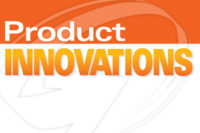Packaging market: Important role for vacuum handling technology
The packaging machinery industry is known for its high specialization. A growing variety of packaging types and materials has led to an increase in the demand for flexibility and efficiency of the machines. This also has implications for automation and handling technology—in particular, for the optimization of process chains. Schmalz Inc. recognized this development early and offers an extensive product range of economical vacuum solutions for transporting products with varying properties quickly and reliably.
 (At right- Image 1: The suction cup SPOB1f is suitable for thinner products from the food industry and provides particularly dynamic handling. Image 2: The thin sealing lip conforms perfectly to any work piece contour and ensures reliable handling.)
(At right- Image 1: The suction cup SPOB1f is suitable for thinner products from the food industry and provides particularly dynamic handling. Image 2: The thin sealing lip conforms perfectly to any work piece contour and ensures reliable handling.)
Products such as candy, dairy products, baked goods, meat, pharmaceuticals and cosmetics will arrive to the consumer intact if they are correctly packaged. Schmalz has decades of experience providing vacuum handling solutions in the packaging industry and operates in a stable sector: According to PACK EXPO owner and producer PMMI, packaging machine production is projected to grow at a compound annual growth rate (CAGR) of 2.4% reaching $8.5 billion in 2020. More than half of this growth is expected to come from the food and beverage sector.
In 2014, US domestic mechanical engineering specialists produced foreign exports worth $19.4 billion , equating to a 12% worldwide share. Germany (23%), followed by Italy (16%), the USA (12%) and Japan (10%). Market research institute the Freedonia Group estimates further increases in demand until 2022 by a yearly average of 4.5%. Turnover in the packing machine sector is currently expanding considerably faster than production volume. While the same number of machines are being produced, a larger turnover is being achieved. Experts attribute this fact to the trend toward higher-quality machines, which are, for example, equipped with integrated quality and process control or run with continuous energy monitoring.
Brand differentiation demands highly flexible packaging solutions
 (At right- Image 3: The Area Gripping System FXP handles cardboard boxes reliably, an intelligent vacuum and pressure switch provides greater transparency in packaging processes. Image 4: The layer gripping systems SPZ feature the ability to handle entire product layers automatically.)
(At right- Image 3: The Area Gripping System FXP handles cardboard boxes reliably, an intelligent vacuum and pressure switch provides greater transparency in packaging processes. Image 4: The layer gripping systems SPZ feature the ability to handle entire product layers automatically.)
Competition and price pressure are high and product changeover times are becoming ever shorter, especially in the consumer industry. This affects the design and type of packaging as well as the flexibility of the machines. Identical or similar contents are often packaged in different materials as a result of brand differentiation. This poses a challenge for handling technology: The machines need to have highly flexible designs to adjust to the frequent changes in package formats. For the operator, it is important that the installed machine components can be easily and flexibly parameterized with the controller. Meanwhile, a whole range of developments influence the packaging itself. In the convenience food sector, for instance, easy-open packaging with integrated cooling or heating pads are in demand. In the higher price ranges, high-quality surfaces with special pigmentation effects or soft textures are popular. Sustainability concerns require materials that are particularly light or biologically degradable. Resource efficiency is also an important aspect affecting the machine components: They must work for as long as possible without requiring maintenance and consume little energy. Demographic changes and the change in household size are influencing packaging sizes and necessitating easy-open packaging.
The advantages of vacuum technology in the packaging industry
From the point of view of the vacuum specialist Schmalz, vacuum solutions must cater to a wide range of packaging types. At the same time, it is important to cover the widest possible range within each product group: For example, a vacuum suction cup should be able to handle many various qualities of cardboard or different types of bag packaging. This reduces the amount of testing work for the user and increases process reliability.
High process reliability and economic efficiency are currently among the main requirements of the packaging industry. Vacuum technology often accounts for only a small proportion of machines but it is still a core element—without it, reliable functioning of the entire process would cease. Manufacturers of packaging machines are often special-purpose machine engineers and so they seek an experienced partner with more process knowledge who can present tailor-made solutions for the application. For this reason, Schmalz offers a packaging-specific range of products.
Using vacuum technology for handling offers clear advantages: For instance, it is significantly more flexible than gripping with pneumatically powered clamps. Due to the rising number of types and sizes of packaging, system operators would be forced to change gripping heads several times a day when using mechanical grippers. Furthermore, they would have to use a high number of different configurations in order to complete different orders. In addition, vacuum handling is very quick: for example pick and place applications today process well over 100 candy or granola bars per minute.
Packaging specialist Pira International lists paper and cardboard as the most commonly used materials worldwide, followed by hard plastic, plastic film, metal, glass and wood. Of the many types of packaging such as folding cartons, bags, vials, syringes, bottles, food cans or beverage cans, bags are showing especially dynamic growth.
For bag packaging, Schmalz offers the new tubular bag suction cup SPOB1f, among other products. This solution is suitable for thinner products from the food industry and provides particularly dynamic handling. Vacuum components are compact, which is another advantage over mechanical grippers: Grippers need much more space beside the product so that they can grip it from the side. On the other hand, vacuum suction cups, such as the SPOB1f, pick up the workpiece from above. Particular caution is necessary with sensitive workpieces such as chocolates and candies. The use of vacuum technology is also advisable in this case, as it is particularly gentle. The user sets the holding force required for the individual workpiece using the vacuum level. This makes it possible to handle products such as vials, cookies and film-wrapped crackers in a reliable yet gentle way.
Schmalz has developed a new suction cup made of metal detectable silicon, which is specially tailored to the needs of customers in the food industry. This solution helps prevent the contamination of food products.
Besides suction cups for handling food, vials, syringes, cardboard boxes and bags, the product range also includes vacuum generators like the basic ejector SBPL. Thanks to efficient eco nozzle technology, this vacuum generator provides a high suction rate for short evacuation and cycle times. It is suitable for the handling of porous workpieces, such as cardboard boxes, packaging materials or insulating materials. What’s more, Schmalz offers the energy-efficient ejector module ecoPump for decentralized vacuum generation directly at the suction cup. Vacuum sensors and valves also make up part of Schmalz’s portfolio.
Schmalz also has vacuum components that can easily read out process-relevant information and visualize it for optimal system monitoring. The compact terminal SCTMi is one such example: With just one cable, up to 16 vacuum circuits can be individually controlled and monitored. The terminal communicates with the controller of the system via IO-Link. Moreover, important process information can be read out with a smartphone or a tablet using NFC technology. This information provides important details to the user about the machine performance, energy consumption, wear and more. Reliable process monitoring enables preventative maintenance, for example, with the goal of further increasing the availability of the machine and optimizing the packaging process.
Besides the single vacuum components, Schmalz offers completely configured vacuum systems. They facilitate a dramatic increase in productivity in automated processes. The area gripping system FXP, for instance, is suitable for handling a wide range of workpieces, regardless of their size, shape or material. With the FXP, users benefit from a significantly higher suction force in comparison to competing products on the market. In addition to the area gripping systems, Schmalz offers the high-performance layer gripping systems SPZ for warehouses and intra logistics. They are available in three designs and feature the ability to handle entire product layers automatically. The layer gripping system even moves incomplete layers, mixed layers, intermediate layers and pallets without difficulty. If desired, it can also be operated in extremely low temperature applications down to -30° C.
And with that, Schmalz covers the entire process chain—from primary and secondary packaging all the way through to palletizing tasks such as end-of-line palletizing.
About Schmalz
Schmalz is a global leader in the field of industrial automation as it pertains to vacuum automation, robotic palletizing vacuum grippers, material handling vacuum lift assist devices and CNC machine vacuum clamping. The company is known for its innovative quality products, which give its customers decisive productivity improvements in their manufacturing processes, as well as its commitment to the environment and its employees. The forward looking 105 year young privately held manufacturer has continually reinvented itself with each generation and has to its credit over 450 patents to date. www.schmalz.com
Looking for a reprint of this article?
From high-res PDFs to custom plaques, order your copy today!





